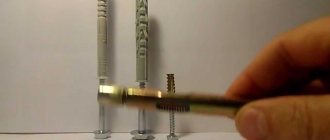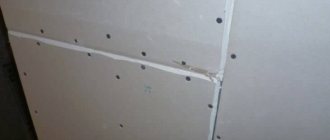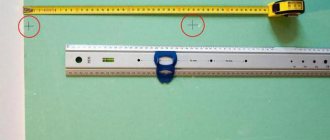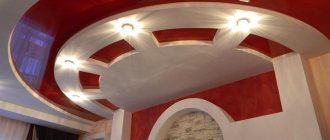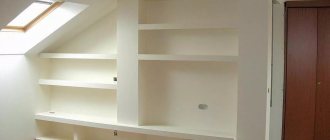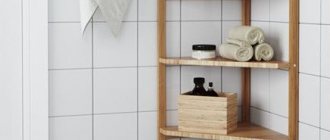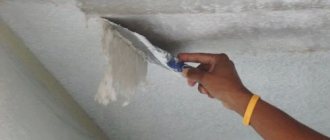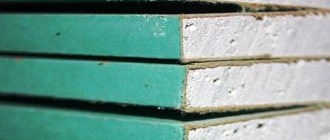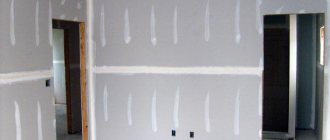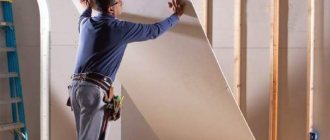11627 0 2
mark_kr May 26, 2017 Specialization: professional in the field of construction and repair (full cycle of finishing work, both internal and external, from sewerage to electrical and finishing work), installation of window structures. Hobbies: see the column “SPECIALIZATION AND SKILLS”
If the wall is covered with gypsum board, then you need to hang the shelves using special fasteners
The question of how to hang a shelf on a plasterboard wall has several possible correct answers. It all depends on what load the structure will place on the gypsum plasterboard sheathing, and what materials we will have at our disposal.
I will tell you how you can hang lightweight shelves with minimal labor, and also describe the technology for installing heavier structures.
How to hang a shelf on a plasterboard wall?
When deciding how to hang a shelf on a plasterboard wall, you need to choose some kind of installation scheme. There are various ways to do this.
Similar articles:
DIY kitchen shelves - it's easy DIY shoe rack DIY wall shelves DIY wooden shelves
Choosing a mounting scheme
It is often necessary to hang a shelf on a plasterboard wall. This material can be subject to deformation, so unnecessary impact on it is undesirable.
When installing and drilling holes, the fragility of the material must be taken into account, otherwise cracks may appear on the wall.
You should estimate the ability of a sheet of drywall to withstand heavy loads. It is also necessary to take into account the method of fastening. When installing heavy shelves, several profiles are used.
Mounting on a mortgage
The most reliable and versatile way to attach heavy shelves . By using this method, you can be absolutely sure of the reliability of the structure, but you need to decide in advance where the shelves will be located.
Embed created during installation of a frame for a plasterboard wall
So:
- even before installing plasterboard for a plasterboard wall, you need to decide on the location of the interior elements;
- a mortgage is mounted - it can be a reinforced metal profile or a wooden block that is screwed to the base;
- on the plasterboard with which the frame is sheathed, marks are placed at the locations of the mortgages;
A mortgage made of metal profiles can be found using a magnet - after finishing the wall, level marks are applied;
- The shelves are installed according to the marks and screwed with screws of the appropriate length, as well as their intended purpose (for metal structures or wood).
shelves mounted on a mortgage have high strength and can withstand a lot of weight.
Mounting on a mortgage is the most acceptable option for hanging a heavy shelf. Even if you decide to rearrange the room, then the shelf can be easily dismantled, and the holes in the place of the screws will be practically invisible. In extreme cases, it will not be difficult to disguise them.
The shelves vary in appearance and assigned functions.
Which method is more suitable for hanging a shelf on drywall is an individual matter. Each person chooses the purpose of the shelf himself. The main thing is to consider the weight of the structure with objects on it.
Watch the video: detailed instructions for attaching shelves to plasterboard walls.
Method 1: glue installation
For small shelves and photo stands, you can use an adhesive installation. To hang a shelf on drywall, you need to prepare a suitable adhesive in advance.
Then do the following:
- Marks are made on the wall surface to install the shelf.
- Then, according to the completed markings, a layer of glue is applied.
- A layer of glue is also applied to the back of the shelf.
- Now you need to wait a little and press the shelf against the wall (do not press it too tightly so as not to damage the drywall).
This method is simple, but the strength and reliability of this design is low.
Tips and tricks
One of the most common fastening options is anchor bolts.
Using this method of fastening allows you to ensure a strong connection and the shelf will not come off. To create such a mount, you will need:
- Working holes are drilled at the locations of future fasteners.
- Now recessed holes are made in the monolithic load-bearing wall.
- The next step is to insert the anchors into the drilled holes.
- Anchor bolts can be used as fastenings or additional brackets can be installed on them.
For small and light objects, Driva dowels are used as an alternative.
But this is acceptable in cases where the drywall is glued and not held on the frame. Despite the apparent fragility of a material such as drywall, with the proper approach and compliance with all work conditions, it demonstrates sufficient strength to hold most pieces of furniture and other objects on the wall surface.
Method 2: fastening with self-tapping screws
Let's find out how to screw a shelf to drywall using self-tapping screws. If the product is light in weight, then self-tapping screws are used. The choice of installation method depends on where the work will take place. If the structure will be installed directly on a plasterboard wall or on part of a wooden frame, then wood screws are used. If you do not heavily load the product, it can be held on by 4 screws.
When a shelf can be installed in a place on the wall where there is a metal profile under the upholstery, then metal fastenings are used. The length of the fastener must be such that the self-tapping screw goes through the sheet of drywall and penetrates into the wood or metal profile.
If the wall has single-layer sheathing, then you need to screw the shelf to the plasterboard wall using self-tapping screws 25-35 mm long.
Stages of work:
- First, choose a location for installation.
- The self-tapping screw must fit into the frame post.
- Markings are applied to the surface of the wall.
- Place the product on the wall and screw the screws to the marked points.
For installation, you should use a screwdriver, then cracks, dents or other damage will not appear on the drywall. The correctly selected depth of screw tightening will ensure a strong fixation of the structure.
If the screws are tightened too much, the reliability of the structure may decrease as a result of deformation of the drywall. You cannot pull out screws that have already been tightened and then screw them in again - in this case, the threads damage the gypsum board and the screws bend.
What is the maximum weight you can hang on drywall?
The maximum load-bearing capacity of drywall depends on a number of factors:
- quality of material;
- reliability of fastening drywall to the wall;
- dimensions and weight of loaded objects.
According to builders and manufacturers, the maximum weight that drywall mounted on a wall can withstand is 55 kilograms.
You should not focus on such a large figure in your planned work. As a rule, in most cases in practice, a comfortable weight in some situations can be either 15 kg or five.
For heavier shelves
Let's look at how to attach shelves to drywall if the weight of the product is large enough. To fix a heavy shelf in drywall, you need to use a special method. It will be necessary to create a special design. First you need to fix the shelf into the profile of the plasterboard sheet. During installation you need to use special fasteners.
- Drill a hole: you should drill through the drywall and the profile under the sheathing.
- A magnet is used to find the location of the metal profile.
- Dowels are installed in the drilled holes.
- The structure is secured with screws (do not tighten too much).
Important: the product should only be mounted on a flat horizontal profile.
Which is better: heated floors or radiators?
Warm floorBatteries
Advantages of this method:
- the structure can withstand heavy loads;
- fasteners must be selected individually for products of different weights and sizes.
The disadvantage of this design is the large amount of time required for installation. If heavy objects are placed on the shelf, the structure may come off.
Method 3: expansion and expansion dowels
Let's find out how to hang a shelf on drywall using special fasteners for drywall - expansion dowels. Let's look at the different types of dowels:
Dowel Butterfly.
| This is a lightweight fastening element consisting of 2 blades. It is installed in the hole. When the locking screw is tightened, its blades open and are pressed against the casing from the inside. | |
| Driva dowel. | It is a fastening element with a deep thread. It is screwed into the casing along a pre-made hole with a diameter of 5-6 mm. This dowel has spiral blades that open up inside the drywall layer when the screw is screwed in. |
| Dowel Fischer Pd. | Made of plastic, it is a sleeve with an enlarged end. When a screw is tightened, its end is pressed into the sleeve, opening it. In this case, the sleeve expands in the skin layer. |
| Molly fasteners. | Is the most popular type. It is fixed into a hole with a diameter of 8-10 mm. When screwing, the teeth located on its neck are stuck into the casing. |
When fixing such dowels, when the locking screw is tightened, the internal fastening part opens and is pressed tightly against the sheet of drywall. In this case, the load from the product will be distributed over a large area.
These types of fasteners have one drawback - high cost. But considering that only a few fasteners are needed for operation, this minus is insignificant.
Method 4: Through Anchor
Let's look at how to attach shelves to drywall using a through anchor. Sometimes it happens that you need to screw a heavy shelf on which a fairly large load will be placed, but dowels cannot be used. This can happen if the gap between the wall and the plasterboard layer is too small, making it difficult to install the spacer sleeve. Then a through anchor is installed.
- Perform markings.
- Make a hole in the casing using a drill. Moreover, the diameter of this hole should be the same as that of the fastener. In order for the structure to be strong, dowels with a diameter of 8-12 mm or more should be used. A dowel with a large diameter will support the weight of the structure. The load on the edge of the hole in the drywall will be the least.
- Make a nest in the wall. You need to take a hammer drill and use a drill to make a nest in the load-bearing wall to install the anchor sleeve. The depth of this hole must be no less than the distance from the outer plane of the cladding to the main wall.
- An anchor sleeve made of metal or high-strength plastic is installed in the resulting socket. It is best to use an anchor with a brass sleeve.
- The sleeve is secured with a locking screw with a head. During installation, the sleeve opens, and the main load goes on the load-bearing wall. This creates a secure hold.
To install the product on a through anchor, the calculations should take into account the loads that the wall can withstand.
When creating a nest with a hammer drill and installing a shelf, the hole in the drywall will gradually increase. Therefore, the anchor must be installed in advance, then during finishing it will be possible to mask cracks or other defects.
Fastening with anchor bolts - Reliable!
One of the most popular fastening methods is the anchor bolt method. This method is known to almost everyone who works with drywall, but it is used extremely rarely. This design consists of fastening directly into the wall through plasterboard sheathing with anchor bolts.
This fastening method is used only if the distance between the wall and the plasterboard is small!
Step-by-step instruction
- A through hole is drilled in the drywall in the place where the drywall rests on the profile;
- Afterwards, a hole is drilled in the wall through the already prepared holes;
- The anchor is mounted into the wall, through the plasterboard sheet and clamped.
- We use an anchor to attach the shelf, or we attach a special fastening to it, for example, a bracket.
This mount is the highest quality and strongest.
Features and Disadvantages
Among the features of this method are:
- Durability;
- Ability to withstand heavy loads;
- It practically relieves the plasterboard sheet of stress.
But there are also some disadvantages, and not a single design can do without them:
- Installation can only be carried out when the structure is built on a metal frame;
- Labor-intensive during arrangement, due to the need to provide holes in the drywall, and then in the building panel;
- The cost is quite high, compared to previous methods;
- Under global loads, or an incorrectly selected anchor, it can destroy not only the plasterboard fence, but also the building panel.
What can drywall withstand?
If the wall is sheathed with a standard gypsum board sheet with a thickness of 12.5 mm, and the frame is standard with a rack installation pitch of 600 mm, then you can expect that the fastening at one point can withstand up to 50 kg of load. It is assumed that this is a constant load, without any permanent vibrations or deformations.
With multi-point fastening, the same 12.5 mm drywall can withstand up to 50 kg/m. sq. In reality, this means that you can hang a shelf on plasterboard or a wall cabinet with two mounts spaced a meter apart for a total load of up to 80kg. The weight of the shelf itself and everything that can be placed on it is taken into account.
Mounting the TV on a special holder involves mounting at 3-4 points, but at the same time they are located close to each other, so the total load still does not exceed 50-60 kg. Taking into account the load when turning and positioning the TV, the weight of the entire structure should not exceed 40 kg.
To secure the indoor unit of the air conditioner, you cannot do without first strengthening the frame under the plasterboard; otherwise, you must first secure the frame base, the fastenings of which distribute the load over at least two square meters, and then attach the unit to it. All this is explained by the presence of vibration during operation of the air conditioner.
How to choose the right mount
Naturally, many controversial issues arise here. But first you need to decide on the weight and size of the shelf, its design and method of operation. And only after that make a conclusion about which method is right for you.
- If you are going to arrange a small shelf, for example, a shelf for a light painting or photo frame, you can secure the shelf with dowels directly to the gypsum board;
- If the goal is a shelf whose depth is more than 10 cm, but at the same time it is intended for books at most, the method of fastening to profiles is suitable;
- If heavy or expensive fragile objects will be placed on the shelf, it is better to play it safe and attach it to the wall.
But if there is no uncertainty about how the shelf will be used, undoubtedly, the choice should be the most reliable anchor method.
What to fasten with what, what hardware is used
For drywall, special fastenings have been developed taking into account the thickness of the material. Under no circumstances should you use ordinary dowels or chops, which would push the material in the hole. Let's first look at an example of how to hang a cabinet on drywall. It most often has two fastenings along the edges of the upper edge in the shape of ears that cling to a pin in the wall or are screwed with a bolt or self-tapping screw with a press washer.
Two types of fastening can be used:
- Molly metal dowel;
- Plastic dowel TNF*W “Butterfly”.
They have a wide edge on the outside, or a washer. On the reverse side, which is inserted into the hole in the wall, there is an expanding part; when a bolt or screw is screwed in, the outermost part of the dowel is pressed against the sheet and bends the consoles to the sides. The result is tight contact around the hole.
The force on the fulcrum should be directed strictly downward; any lateral directions will contribute to the destruction of the plaster and weakening of the fastening. Before hanging the boxes on drywall, you should check that the fastenings will in no way touch the communications laid in the wall. Because even though the dowels themselves may not ultimately reach, for example, the corrugation in which the power cables are laid, when drilling holes it is quite possible to damage them.
The procedure is simple:
- At the required mounting height, a horizontal line is marked strictly level.
- The positions of the attachment points are marked.
- Two holes are drilled for the corresponding dowels.
- A dowel is inserted and a self-tapping screw with a hook at the end is screwed into it or a clamping bolt is tightened. Finally, screw the fastener all the way in so that the hook points upward.
- The cabinet is hung on the brackets.
What is important to remember when performing work? Firstly, the line for installing the fasteners will be higher than the level of the upper border of the cabinet. Secondly, since the eyelet itself, by which the cabinet is hung, is often pear-shaped, you should measure along the top of this hole. Before hanging the cabinet on drywall, you should check the fastenings so that they do not wobble and sit firmly in place, and the hooks do not turn.
As reinforcement, you can install a 1-1.5 cm thick strip along the bottom border of the cabinet, secured to the drywall with two or three dowels with self-tapping screws.
Installation of decorative shelves, paintings, light lamps
For these purposes, using dowels with a butterfly end does not make sense, but you cannot use a simple self-tapping screw either. In the first case, the fasteners will be too massive, in the second, unreliable. If the self-tapping screw is only screwed into plaster, it will quickly become loose, destroying the material. Even if it hits the profile, sooner or later the fastener will begin to reach.
You should use a special dowel for drywall. It has the shape of a truncated cone and wide-profile threads with a large pitch. The diameter is often up to one centimeter. These dowels are called DRIVA or snail dowels. There may be dowels with or without a drill at the end, metal or nylon.
For drywall, DRIVA nylon dowels with a drill at the end and a length equal to the thickness of the drywall sheets on the wall, no more and no less, are best suited. They have a cross-shaped groove at the end for easy tightening using a Phillips screwdriver.
- The locations of the fastenings are marked at the central points.
- Using a screwdriver and a cue ball with a cross-head bit, screw in the dowel until it stops.
- A shelf or other element that needs to be secured is leaned against and a self-tapping screw with a press washer is screwed in.
It all comes down to using only special fasteners for drywall, which are not more expensive than usual, but provide reliable fastening and do not create preconditions for cracking and destruction of the gypsum inside the material. You can hang almost anything on drywall, as long as you take into account its strength and follow simple instructions.
Do not forget that during drilling a large amount of dust is generated, especially considering the composition of a material such as drywall. You will need to worry about protecting the room from dust, as well as personal protective equipment when carrying out such work. You can attach shelves to a plasterboard wall using special dowels.
Such fasteners can be of various types, but one of their advantages is that when screwed into the wall, they begin to open, thereby forming sufficient support and taking on a significant part of the load. To secure such shelves, a special design will be required; firstly, it will be necessary to mount the structure strictly in the profile of the plasterboard sheet, and secondly, the use of special fasteners.
- Its installation will require quite a bit of time;
- Thanks to the use of dowels, it is quite durable as long as the shelf is used properly.
Advice! The screws are screwed in with a screwdriver, but not completely. The final screwing must be done with a Phillips screwdriver, with a little force.
- Glue – you can glue a light weight shelf, which will serve as a decorative element. This could be a shelf with a figurine of “Venus”, with a small beautiful picture;
- Dowel-nails - the shelf can be made of lightweight material. It is possible to put car and apartment keys, a mobile phone and other light essentials on it;
Typically, plasterboard walls are sheathed in one layer. The sheet thickness is 12.5 mm. When you are renovating a room, think in advance about whether there is a need to place heavy objects on such a wall. If yes, then do not skimp on making the wall with two layers of gypsum board.
Then its resistance to shelves, equipment or paintings placed on it will almost double. We select the size of the dowel based on the dimensions of the protrusion and the expected mass of things that we plan to place on it. The larger both parameters are, the longer the dowel - the nail will have to be used. Today we will talk about how to attach a shelf to a plasterboard wall if the plaster crumbles and cannot withstand this kind of load? Important! If the dowel is difficult to drive, bends or breaks, take another drill or drill a hole. The dowel should go to the full depth of the hole. Today, not only ceilings are covered with plasterboard, but also walls are leveled. Although this material has a number of advantages, it still has a small drawback - fragility when hanging heavy objects on it: shelves, cabinets, paintings, etc. Therefore, the question very often arises “how to hang a shelf on drywall”? Please note !
The drawing must indicate not only the dimensions of the wall and the shelves themselves, but also the distance between them, as well as the distance to the floor. When creating a diagram, you need to take into account both the placement of shelves on the wall and their functional purpose.
What is the use of drywall/drywall screws?
However, without a drill I have to stick them into the wall. Can I use regular hanger screws that won't take a lot of weight? In this case it is a hanger with hooks.
Tester101
imbrian reed
bib
There are several approaches to hanging weights on drywall/plasterboard.
Light Duty - The most common anchors used for light duty applications are flared tubes that grip the sides of the hole they are in and expand slightly behind the hole.
Others, like yours, have wide threads to capture more surface area in the drywall itself. Some of these threaded anchors have a flared end and some do not.
The limitation of all of these types is that they rely on a small area of drywall to remain strong to hold them up. They are good for light loads and when subject to shear forces. When installed on a wall, this means that most of the force is pulled down along the wall (as if you were trying to cut a screw in half right against the wall).
If a large load is placed on these anchors, a significant external force is generated, i.e., pushing away from the wall. In a coat hanger, part of the load moves (downwards) and part of it moves outwards. This puts stress on the sides of the hole in the drywall, causing it to crumble. This is even worse when the load is dynamic (moving) rather than static (stationary). The hanging coat is static. The coat, pulled out by the hook, is dynamic. And almost all of this load goes externally.
Threaded anchors distribute the load better, but do not withstand significant loads. Sometimes this is compensated by using a large number of anchors. An improvement, but usually not a good solution.
Plastic (or similar metal) anchors are almost never suitable for ceiling mounting where the entire load is away from the ceiling surface.
Medium Load – Medium load anchors pull back a larger area behind the drywall to distribute the load.
Expansion anchors fit into a hole like a tube and are then expanded behind the hole using a screw, bolt, or tool.
There are also switch-type anchors where the flaring section either rotates or pushes out to cover a larger area.
The advantage of these anchors is that they distribute the load well beyond the hole in the dryest anchor. Although the hole may crumble, these anchors rest on a section of solid drywall 1 to 2 inches around the hole. This gives the anchor much greater strength to withstand external medium load loads as well as shear resistance. However, large external loads, especially dynamic ones, act on several inches of thin plaster and paper. Again, adding multiple anchors helps distribute the load.
Some of these anchors can be removed and reattached, and some are not (for example, spring anchors will fall off in the wall when the bolt is removed).
Heavy Duty - On a plasterboard wall, heavy-duty mounting directly into the framing members is preferred.
The most common approach is to find studs, post framing users that will accommodate the wall surface. It's either wood or steel. The screws are driven into the piece being mounted, through the drywall and into the middle of the stud. An alternative is to screw cross braces into the frame. These are sections of wood or steel that run horizontally to support a wall or act as a fire barrier. They are slightly less durable than uprights, but from a practical standpoint they can handle all but the heaviest loads.
Studs and cross braces can be found using a stud finder.
The screws should be long enough to fit at least 1 inch into the wood stud, and longer if the load is particularly heavy. Steel studs should use finer threaded screws (sheet metal screws) and length is not an issue.
In wood framing, an alternative to regular screws are hanger bolts, which can be screwed into the studs and leave the bolt on the outside of the drywall to hang the object.
The benefit of hanger bolts is the ability to easily remove and reattach the weight using a nut or wing nut.
When you don't have a framing element in the right place, sometimes it's worth the effort to add one. Some of the drywall can be removed from this area, a cross brace inserted exactly where you want to install, and pushed horizontally towards the two support studs on each side. You can then lay down a drywall patch to cover the cross brace (using a removed section of drywall or a new piece).
How to hang a shelf on a plasterboard wall: simple and complex methods
When the screw is screwed in, the butterfly dowel folds and forms a support platform on the back side of the gypsum board, distributing the load over a large area. The fastener can withstand forces of up to 7-10 kgf.
- They must have the maximum area. The larger the area, the lower the specific load on the gypsum board;
- They should be pressed tightly against the drywall on the side where the hanging furniture is mounted. The instructions are quite obvious: otherwise the lining of the frame will simply be pressed through;
- The mortgages must be securely fixed (best of all, glued to the back side of the gypsum board using liquid nails, silicone sealant or any universal glue).
The obvious drawback of the method is that the attachment points cannot be located in arbitrary places: the standard step between profiles when assembling the frame is 60 centimeters. It is related to the width of the gypsum board (120 cm): if the width is a multiple of the pitch of the sheathing or frame, the edges of the sheet will fall exactly on the center of the profiles. Using the so-called Molly anchor. The structure of the product will seem familiar to you: it strongly resembles a butterfly dowel. The only difference is that this type of fastener is all-metal and is designed for heavy loads.
Note: the head of the fastener must be held with pliers, pliers or any other tool. The fact is that when the bolt is tightened, it can turn, crumbling the drywall around the attachment point.
How to attach shelves to drywall: solutions
Advice! If you use small dowels, you need to keep in mind that most of them should be in the wall, not in the sheet. Otherwise, the fasteners can easily be pulled out from the installation site. Let's move on to finishing. We take a large spatula, spread a universal putty and apply a layer to the surface of the material. In this way we process all the attached sheets. The back part of the structure is ready. Now we insert the jumpers from the main profile into the grooves of the guide and fix them with metal screws.
Next we fix the guides that form the front part of the shelf.
- a screwdriver (you can use a drill with a special attachment inserted instead);
- perforator;
- metal scissors;
- drywall knife;
- building level;
- plane (it’s better to take a small one, it will be more convenient to work with).
When designing a shelf, you don’t have to limit yourself to standard shapes. After all, drywall is a fairly malleable material. With its help you can create quite unusual bends.
How to hang a shelf on a plasterboard wall
Let's find out how to screw a shelf to drywall using self-tapping screws. If the product is light in weight, then self-tapping screws are used. The choice of installation method depends on where the work will take place. If the structure will be installed directly on a plasterboard wall or on part of a wooden frame, then wood screws are used. If you do not heavily load the product, it can be held on by 4 screws.
Let's look at how to attach shelves to drywall using a through anchor. Sometimes it happens that you need to screw a heavy shelf on which a fairly large load will be placed, but dowels cannot be used. This can happen if the gap between the wall and the plasterboard layer is too small, making it difficult to install the spacer sleeve.
Then a through anchor is installed.
- the structure can withstand heavy loads;
- fasteners must be selected individually for products of different weights and sizes.
- First, choose a location for installation.
- The self-tapping screw must fit into the frame post.
- Markings are applied to the surface of the wall.
- Place the product on the wall and screw the screws to the marked points.
If the screws are tightened too much, the reliability of the structure may decrease as a result of deformation of the drywall. You cannot pull out screws that have already been tightened and then screw them in again - in this case, the threads damage the gypsum board and the screws bend.
Fastening the shelf with dowel nails
This method is applicable if the load on the shelf is small, but at the same time, fastening with glue is not suitable. Fasteners are selected based on the location of the structure:
- The plasterboard wall has a wooden frame.
- A gypsum board wall contains metal elements.
- The surface was leveled with plasterboard using a frameless method.
Depending on the weight of the shelf, different types of dowels are applicable
Attention! The length of the fastener must be such as to pass through the shelf material, drywall, frame and be firmly fixed in it. For example, if the wall is made of one layer of gypsum board on a metal frame, the fasteners should be 35 mm long.
Installation algorithm:
- Choose a place for the shelf; it is advisable that the fastening is on the sheathing: vertical or horizontal;
Before attaching the shelf, you should take measurements and markings - Apply markings. To do this, you will need a simple pencil or chalk (the drawing instrument should be easily erasable). You will need a level to ensure the item is mounted evenly.
- Place the shelf against the marks, check the levelness and height from the floor (comfort of use).
The shelf is applied to the plasterboard wall and the levels are checked - Using a drill, you need to make a hole with a diameter that matches the size of the dowel.
The size of the drill bit can always be adjusted to the size of the dowel - Using a hammer, carefully insert the dowel into the hole you made.
- After this, fix the shelf with a self-tapping screw. If it is hung with hidden hooks, then after completely screwing in the self-tapping screw to the head, use a screwdriver to unscrew the fastener 2 turns. Hang the shelf on this fastener.
The shelf with dowels can support sufficient weight
After installation, the shelf can be used depending on its purpose.
How to hang a shelf on a plasterboard wall: 5 installation methods
For decorative shelves, stands for small photographs or keys in the hallway, you can use adhesive mounting. This method is the easiest to implement: If you tighten it too tightly, the reliability of the fastening may decrease due to the violation of the integrity of the cardboard layer. And it is also undesirable to unscrew the screws and re-tighten them back: the thread destroys the plaster, and when re-attached it will hold much worse.
If we are dealing with a structure whose mass is small, but does not allow the use of the adhesive method, we can simply fix the shelf with self-tapping screws. The choice of fasteners depends on where we will carry out the work:
- First, using a drill or screwdriver with a drill bit installed, we make holes in the plasterboard sheathing. The diameter of the holes must be equal to the diameter of the fasteners used.
Now let's figure out how to hang a heavy shelf. Here, ordinary self-tapping screws are not enough - it is advisable to either use special dowels or solve the problem in other ways.
How to treat the surface → Room decoration → How to choose the right paint → Surface treatment technologies → Leveling and finishing the walls → Selecting and applying a primer → Removal from the surface → Stretch ceilings and technologies → Reviews and testimonials
